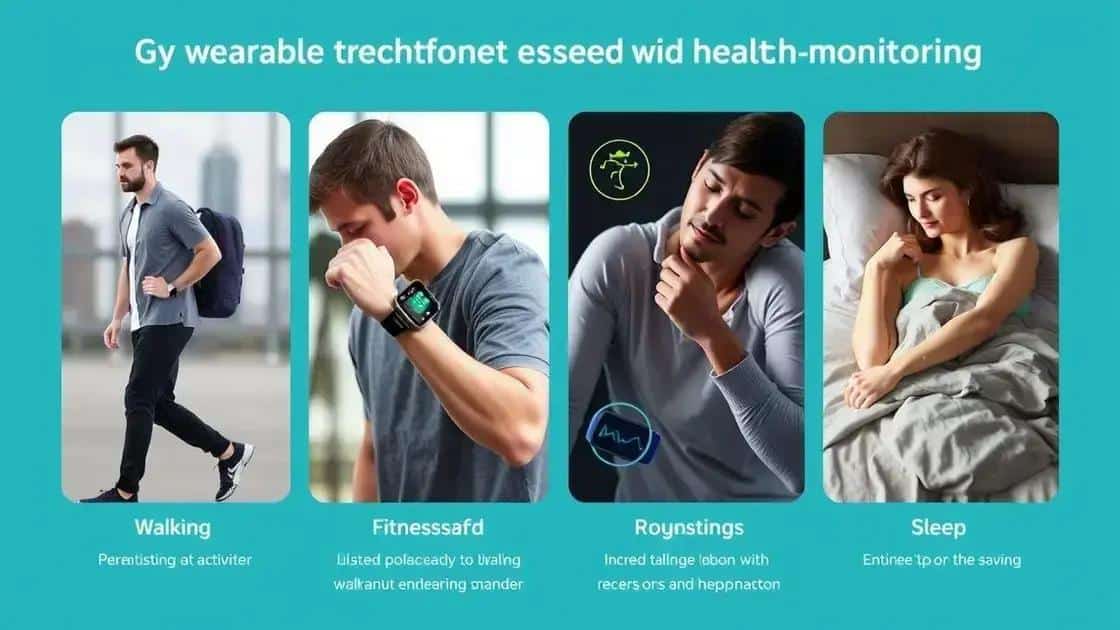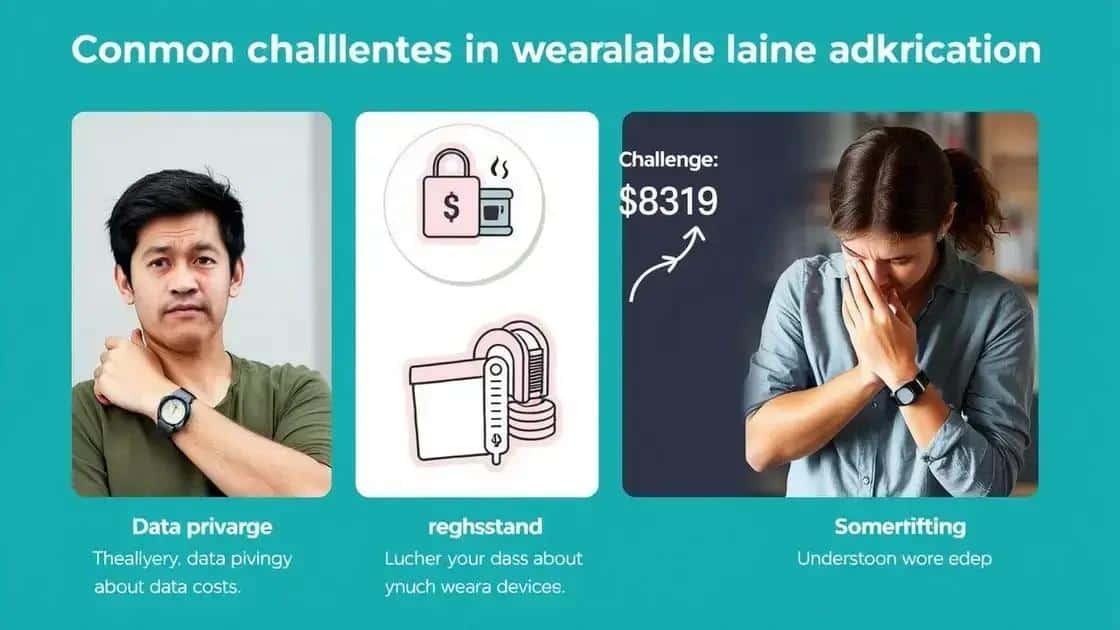Insights on wearable tech innovation: shaping the future

Wearable technology enhances health monitoring by providing real-time data on vital signs, activity levels, and sleep patterns, allowing users to make informed health decisions and manage their well-being effectively.
Insights on wearable tech innovation show us how these devices are not just gadgets but integral parts of our daily lives. Ever wondered how they might enhance your health or productivity? Let’s dive in.
The evolution of wearable technology
The evolution of wearable technology has been impressive. It started with basic devices and now includes sophisticated gadgets that fit seamlessly into our lives. Initially, wearables were primarily focused on fitness and health tracking. Now, they extend to multiple functionalities, including communication and even assisting in daily tasks.
Key Milestones in Wearable Technology
Over the years, various innovations have shaped the landscape of wearable tech. Each milestone brings us closer to integrating these devices into our daily routines. Some significant developments include:
- **Fitness trackers**: The first popular wearables that helped individuals monitor their physical activities.
- **Smartwatches**: Devices that not only tell time but also receive notifications and track health metrics.
- **Augmented reality glasses**: Innovations like Google Glass offer unique visual experiences.
- **Smart clothing**: Fabrics infused with technology for health monitoring and comfort.
As technology advances, wearables continue to become more sophisticated. Companies are investing in new features for smarter health tracking and seamless connectivity. Wearable tech is also adapting to user needs, with designs that are more comfortable and practical for daily wear.
Impact on Daily Lives
The impact of wearable technology on our daily lives is profound. People use wearables to track their fitness goals, monitor health conditions, and even receive alerts without needing a smartphone. This convenience has made them indispensable for many. Imagine checking your heartbeat or calorie count with just a quick glance at your wrist!
Moreover, the integration of artificial intelligence into wearables allows personalized experiences. Devices can learn user habits and provide actionable insights. This capability enables users to make informed health choices.
With the rise of smart home technology, wearables are also beginning to interact with other devices in our lives. For instance, smartwatches can control lights or home security systems, making our lives even more interconnected.
As we continue to embrace the digital age, the evolution of wearable technology showcases exciting possibilities for the future. Future advancements will likely include improved health diagnostics and even more seamless user interfaces, embedding technology deeper into our daily lives.
How wearable tech enhances health monitoring

Wearable tech has transformed health monitoring in ways we never imagined. These innovative devices provide real-time data that helps users stay on top of their health. By tracking vital signs, wearables empower individuals to make informed decisions about their well-being.
Key Features of Wearable Health Tech
Many wearable devices come equipped with features that enhance health monitoring. These features allow users to keep a close eye on their fitness and overall health. Some of the key features include:
- **Heart rate monitoring**: Continuous tracking of heart rate enables users to understand their cardiovascular health better.
- **Sleep tracking**: Understanding sleep patterns helps users improve their sleep quality and establish better routines.
- **Activity tracking**: Monitoring daily steps, workouts, and overall activity levels encourages a more active lifestyle.
- **Calorie tracking**: Managing calorie intake and expenditure can help in effective weight management.
As technology continues to evolve, wearables provide data that can predict potential health issues. For instance, devices can alert users to irregular heartbeats or changes in activity levels that might indicate a health problem.
Benefits of Real-Time Monitoring
The benefits of real-time monitoring are immense. With immediate access to health data, users can respond to changes right away. This proactive approach can lead to early detection of issues, which is crucial for timely intervention. Additionally, sharing this information with healthcare professionals can enhance treatment decisions and overall health management.
Moreover, the convenience of having health metrics on a device worn daily makes it easier for individuals to develop better health habits. Many users report feeling more motivated to exercise or maintain their health due to the insights provided by their wearables.
In today’s fast-paced world, leveraging the capabilities of wearable technology allows individuals to take control of their health like never before. The integration of personalized insights and user-friendly interfaces makes staying healthy both manageable and achievable.
Future trends in wearable innovation
Future trends in wearable innovation are shaping how we think about health, communication, and lifestyles. Technology continues to evolve, making wearables more sophisticated and user-friendly. As we look ahead, it’s clear that wearables will not only track health but also play a role in enhancing our daily lives.
Integration with Smart Home Devices
One exciting trend is the integration of wearables with smart home technology. Devices can communicate with each other, allowing users to control their environment through wearables. Imagine adjusting your home lighting or temperature with just a tap on your smartwatch!
- **Voice control capabilities**: Using voice commands on wearables lets users control their smart home seamlessly.
- **Energy management**: Wearables can monitor energy usage and suggest ways to save.
- **Security features**: Users can use wearables to monitor home security cameras.
- **Personalized comfort settings**: Homes can adjust automatically based on the wearer’s preferences.
These integrations help create a cohesive living environment where technology enhances daily routines. This trend is likely to grow as more smart devices become available.
Advancements in Health Monitoring
The future of health monitoring will see wearables offering even more advanced features. New technology is being developed to track a wider range of health metrics, such as blood glucose levels and blood pressure. This capability will provide users with comprehensive health insights without needing to visit a doctor frequently.
Furthermore, personalized health recommendations based on data collected will become common. Wearables will analyze user activity and offer tailored fitness plans or dietary suggestions. These advancements can lead to better health outcomes as individuals receive support tailored to their specific needs.
Artificial intelligence will also play a significant role in developing wearables. AI can process data faster and more accurately, allowing users to receive quicker and more reliable health information. Imagine having a wearable that can predict health issues before they arise!
As we embrace these trends, it’s evident that the future holds exciting possibilities for wearable technology. From smarter integrations to advanced health monitoring, wearables will continue to revolutionize our lives.
Challenges in wearable tech adoption

Challenges in wearable tech adoption are significant and impact how quickly people embrace this innovation. Although wearables offer many benefits, several hurdles can slow their acceptance in daily life. Understanding these challenges can help us find solutions to improve adoption rates.
Privacy Concerns
One of the biggest challenges is privacy. Wearable devices collect a lot of personal data, from health metrics to location information. Users often worry about how this data will be used and whether it might be shared without their consent.
- **Data security risks**: Hackers can potentially access sensitive information if devices are not properly protected.
- **User trust issues**: If companies do not communicate transparently about data usage, users might hesitate to adopt wearables.
- **Legal implications**: Regulations around data protection are evolving, which can confuse users about their rights.
- **Anonymity challenges**: Users may feel they lose anonymity when using devices that track their daily activities.
Addressing these concerns is essential for increasing user confidence in wearable technology.
Cost and Accessibility
Another challenge is cost. While wearable devices are becoming more affordable, high-quality models still come with a price tag that not everyone can afford. This limits access for some people who would benefit from using wearables.
In addition, there is often a lack of understanding of how to use these devices effectively. Some users may find the technology complicated or intimidating. This can create barriers to entry, especially for those who are not tech-savvy.
Furthermore, wearables need to be comfortable and user-friendly. If a device is bulky or difficult to understand, it is less likely to be adopted.
As wearables continue to evolve, addressing these challenges will be crucial to increase acceptance. Improving data protection measures, reducing costs, and enhancing ease of use can significantly influence how quickly people adopt wearable tech into their lives.
In conclusion, the journey of wearable technology continues to grow, bringing both exciting opportunities and challenges. As we move forward, it is crucial to address privacy concerns, reduce costs, and enhance user experience to encourage wider adoption. With continual advancements in design and functionality, wearables have the potential to transform how we manage our health and integrate technology into our daily lives. Embracing these innovations will lead to better health outcomes and improved overall well-being, making wearables an essential part of the future. It’s important for consumers and manufacturers to work together to overcome obstacles and unlock the full potential of wearable technology.
FAQ – Frequently Asked Questions about Wearable Technology
What are the main benefits of wearable technology?
Wearable technology offers real-time health monitoring, increased convenience, and integration with smart devices, helping users manage their health and activities effectively.
How does wearable technology handle privacy and data security?
Wearable devices collect personal data, so it’s important for manufacturers to implement strong security measures and provide transparency on how data is used.
What are some common challenges people face when using wearables?
Common challenges include privacy concerns, high costs, and difficulties with usability or integration with other devices.
Are there any future trends in wearable technology?
Future trends include better health tracking capabilities, enhanced smart home integration, and personalized user experiences driven by artificial intelligence.





